I’ll be bringing some 480 odd Magic The Gathering cards with me to Australia – 8 decks of 60 cards apiece (plus perhaps a handful of sideboard cards).
Magic is a card game where the goal is to reduce the life points of your opponent(s) to zero. You do this by playing various types of cards from a deck assembled beforehand. It has been around for many years now (17 actually) and there are apparently over 7000 unique cards (amost 11000 cards in total). The possibilities for deck creation are therefore essentially endless, and the variety of the cards coupled with the complexity of the game itself makes the creation of a 60-card deck an exquisite exercise in strategy.
I don’t have anywhere near 7000 unique cards. But I probably do have about 2000, so making my 8 decks was still extremely enjoyable. I self-imposed a few rules to the process (and ignored some of the official rules, such as the ban list), foremost of which was no duplicate cards (alternate art cards were considered unique). I also bended the land rule-of-thumb a bit, but stuck to exactly 60 cards for each of the 7 decks I assembled.
This post is a bit of a primer on each deck to give BS and AW (and possible AS?) an idea of what they’ll be playing with in less than a month. Each deck is described in turn, with a couple of the cards contained therein to give an idea of the theme.
Black
![]()
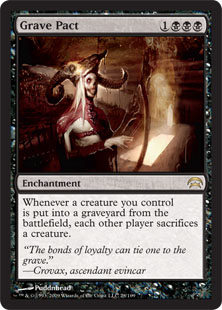
Black is awful, as in it should be fun to play but a real horror to play against. It’s all about sacrifice and discard, and utilizes graveyard recycling. In a perfect world Grave Pact will be triggered by cards the black player himself chooses to sacrifice, and then followed by Beacon-ing something nasty from an opponents graveyard.
There are… other elements to this deck as well, including a 10-tonne surprise. Suffice to say the above two cards are only half of what makes this deck truly nasty to play against!
Green
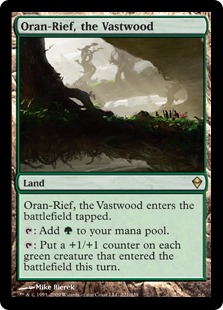

I’m a little concerned about the viability of green, since the deck (partly due to necessity) follows the archetype of “big monsters fast” with lots of mana-boosting and big creatures – a strategy that can easily be shut down by some of the more technical decks. Much will depend on the draw (and the opponent), but if such things like the above combo of 6 2/2 creatures in one turn pays off, this deck will be a force to be reckoned with.
Blue

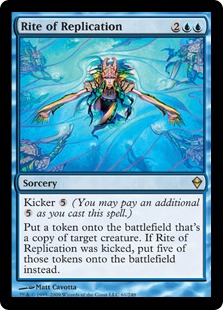
Cards like Rite Of Replication are what make MTG players get all tingly inside… “Imaging casting a kicked version of that onto a…?” For the players of my blue deck, I imagine the target will more likely be an opponents beast than theirs simply because blue focuses more on denial and countering than getting the big guys out. This decks win mechanism is a bit sneaky (especially since I made all the decks, so I know it will be tough to counter) and – if it works – won’t even rely on such legenedary cards as the (costlier) reprint of Time Walk seen at left above.
To be true, in my initial test-plays, blue seems to be the most powerful of the decks I have made. We shall see…
Red
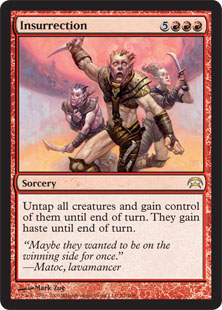

There’s clearly a typo on the card at left above, since I am sure the name should have read “Win The Game”. Red is a monster of direct damage and fast, low-cost creatures. With the right draw, when this deck wins it will do so quickly. It also contains a few cards that are much more lethal in multiplay than in versus (such as Insurrection). I am a little disappointed though that I have but one Lightning Bolt card, despite it’s return in the 2010 set (as a common, no less!). Maybe I should check the bins at the game stores for at least one more… how much could a common go for?
White
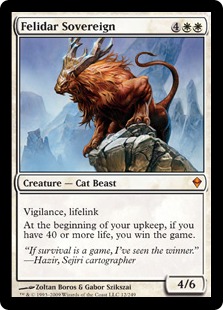
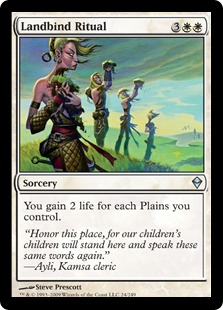
…aka the ‘gimmick’ deck.
This is a life-gain deck built around the alternate win condition of the mythic rare Felidar Sovereign seen above. Can it work? Yes. Will it work? Unlikely. Black and blue for instance, will shut it down almost without even trying. Red will probably damage faster than the life can gain, and green’s big creatures will overcome the little guys in this deck too quickly. Furthermore, I don’t exactly own the strongest life-gain cards, far from it in fact. I’d love, for instance, to include a Wall Of Reverence in this deck.
But if this deck does work it’s going to be so much fun, and for that reason this is the deck I am most looking forward to playing. Oh, and also because of the big secret I haven’t revealed in this preview 🙂
Gold
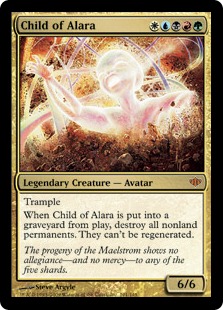

In MTG, ‘gold’ cards are those with casting costs (the upper right corner) that include more than one colour of mana. Typically it’s harder to play a multicoloured deck, so the monsters are overpowered for their relative cost than a monocoloured version. Child Of Alara is one such example – a 6/6 trampler for 5 mana with that awful death condition would never exist were it just one colour.
The gold deck is a crapshoot, and I think perhaps the weakest of all the 7 decks I have made. This is partially because I have fewer gold cards, and partially because of the difficulty of getting the available mana in a timely manner. Even so, like all these decks I expect it will be fun to play (a few of it’s cards in particular are intriguing) and with a good early draw I could see it even winning the odd game or two!
Artifact

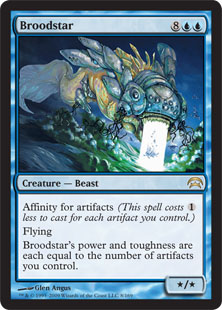
In a test game, I had Broodstar on the table, as a 6/6 beast, on turn 3. Two turns later, he was 17/17, and he wasn’t the only creature on the field above 10/10. This deck is like a bomb just waiting to go off, and when it does the opponent may as well concede. I can’t wait to see how it fares in multiplay against such things as black or red.
The 8th deck is the pre-made Slivers tournament deck, which remains in the box unopened (I’ll look at it some time before Christmas). I have no idea how powerful it is, but I hope not too great since I would hope all 8 decks I’ll be bringing are competitive. We won’t know the answer to that until countless actual games have been played, but at this point I can’t help but expect to see Black or Blue close to the top of the rankings in both versus and multiplay.
I guess we shall soon see.
Fun times ahead. But where’s your all-land deck, mate? 🙂